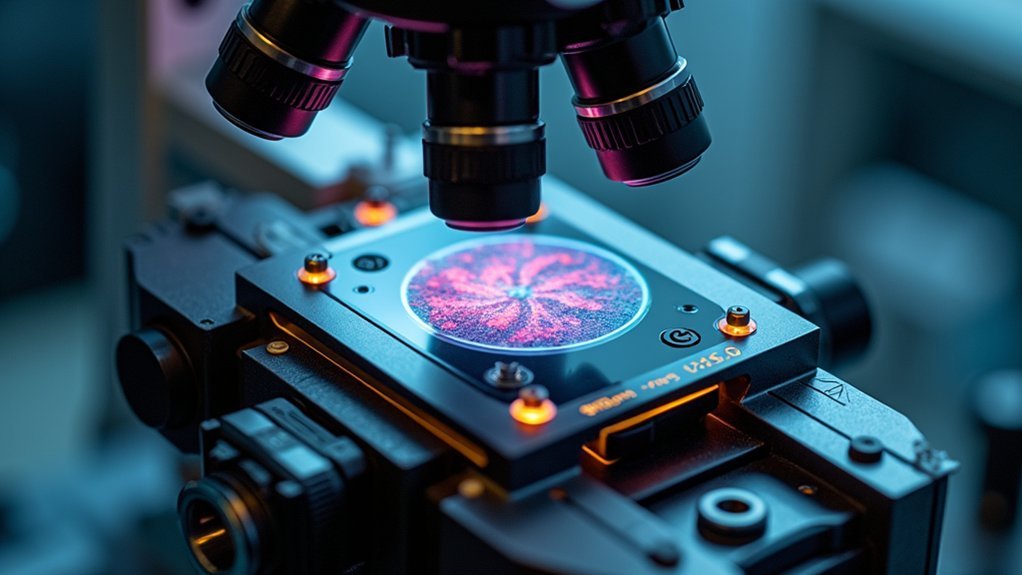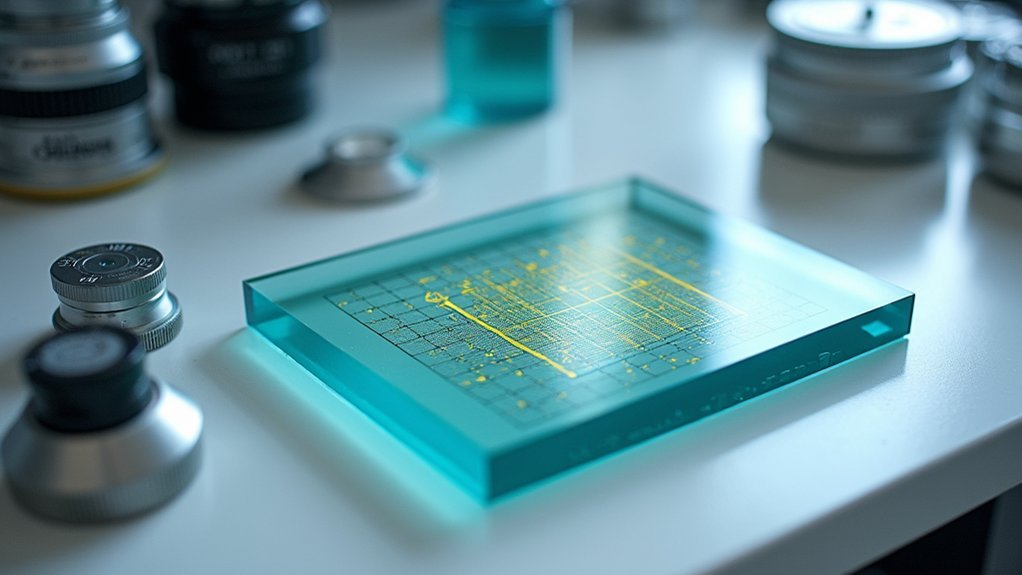Achieving perfect focus in scientific photography requires specialized tools. You’ll need fine focus adjustment knobs for precision, z-stacking software to overcome depth of field limitations, motorized stage systems for accurate positioning, specialized objective lenses with ideal numerical aperture, and focus calibration tools to verify sharpness. These essentials help you capture crisp, detailed images for research and documentation purposes. Each tool addresses specific challenges that stand between you and publication-quality scientific imagery.
Fine Focus Adjustment Knobs and Digital Controllers

When capturing microscopic details where every micron matters, fine focus adjustment knobs and digital controllers become indispensable tools in your scientific photography arsenal.
These mechanisms allow you to achieve ideal clarity and sharpness in your specimens by making incremental adjustments that manual focusing can’t match.
You’ll find that digital controllers enhance focusing accuracy by providing electronic feedback, particularly valuable when working at high magnifications.
By integrating these tools with your imaging systems, you’ll benefit from motorized controls that enable remote adjustments and streamline your workflow.
Combining both fine focus adjustment knobs and digital controllers greatly reduces focusing time, making your image capture more efficient.
This integration is especially important when collecting scientific data where precision is paramount and even the slightest blur could compromise your results.
Z-Stacking Software for Extended Depth of Field
Three key limitations in scientific photography can be overcome with Z-stacking software: shallow depth of field, loss of detail, and focusing challenges.
When you’re capturing intricate subjects in macro photography, you’ll find that Z-stacking software creates composite images with razor-sharp details throughout your entire subject.
Programs like Helicon Focus, Zerene Stacker, and Adobe Photoshop analyze multiple images taken at different focus increments, selecting only the sharpest areas from each to create a single thorough image.
Z-stacking software precisely extracts the sharpest details from multiple images, creating one comprehensive composite with complete focus throughout.
For best results, you’ll need to maintain consistent lighting across all photos and carefully plan your focus steps.
This technique proves invaluable in scientific photography, particularly microscopy, where capturing complete specimen detail is essential.
Motorized Stage Systems for Precise Sample Positioning

Motorized stage systems represent the backbone of precision movement in scientific photography, advancing your imaging capabilities beyond what Z-stacking software alone can achieve.
With high-resolution encoders delivering sub-micron positioning accuracy, you’ll capture details previously impossible to document across X, Y, and Z axes.
You’ll find these systems especially valuable in biological imaging and materials science, where sample alignment critically affects measurement accuracy.
By integrating with software for automated imaging processes, you can program the stage to capture multiple images at predefined positions, eliminating manual repositioning errors.
The most advanced systems offer programmable movement patterns and autofocus capabilities, streamlining your workflow when dealing with complex samples.
When precise sample positioning is non-negotiable for your research, a motorized stage system becomes an indispensable focus tool.
Specialized Objective Lenses for Variable Depth Control
The mastery of depth control in scientific photography hinges on your selection of specialized objective lenses. When you’re capturing microscopic details, the right lens dramatically affects both resolution and depth of field. Achromatic and apochromatic configurations minimize chromatic aberrations, ensuring your images maintain true color accuracy across all focal planes.
The nuanced art of microscopic imaging requires precise lens selection to achieve optimal depth manipulation and clarity.
- Higher numerical aperture (NA) lenses provide superior light gathering capacity, enabling you to resolve finer details while precisely controlling depth of field in your scientific photography.
- Oil immersion objectives deliver extremely shallow depth of field with enhanced resolution, ideal for examining specific layers of complex specimens.
- Variable magnification lenses allow you to adjust focus dynamically, revealing different structural layers without changing equipment—particularly valuable when documenting multi-layered biological samples.
Focus Calibration Tools and Reference Slides

While specialized lenses provide optical capability, precise focus calibration tools guarantee your scientific images achieve their peak potential resolution. Reference slides featuring standardized patterns and grids are essential for verifying accurate sharpness, particularly in microscopy and astrophotography.
You’ll find a depth of field calculator invaluable for determining ideal aperture and focusing distance across your subjects. Regular calibration prevents common issues like back or front focus that compromise scientific imagery quality.
Professional photographers incorporate these tools into their workflow to maintain consistency in photographic documentation. By integrating calibration charts and test targets into your scientific photography routine, you’ll guarantee that fine details are captured with precision.
Your optical systems will perform at their best, delivering reliable results that meet the exacting standards required in scientific fields.
Frequently Asked Questions
What Is the 20-60-20 Rule in Photography?
You’ll compose images by dedicating 20% to your subject, 60% to contextual background, and 20% to negative space. This rule creates visual balance while guiding viewers’ eyes to the focal point effectively.
What Are the Focusing Techniques in Photography?
You can use manual focus, autofocus, focus peaking, hyperfocal distance, and focus stacking. Don’t forget zone focusing, selective focus, and using the DOF preview button for better composition results.
What Is the Most Important Tool in Photography?
Your camera is the most important tool in photography. It’s your primary image-capturing device, but don’t overlook quality lenses, understanding exposure settings, using a tripod, and mastering post-processing software too.
What Do You Need to Be a Scientific Photographer?
You’ll need scientific education, strong photography skills, diverse portfolio, technical expertise with cameras and lenses, and commitment to continuous learning in both science and photography to effectively communicate complex concepts through visual imagery.
In Summary
You’ve now discovered the five essential tools to elevate your scientific photography. Whether you’re fine-tuning with digital controllers, creating depth with Z-stacking software, positioning samples with motorized stages, controlling depth with specialized objectives, or ensuring accuracy with calibration tools, you’re equipped for success. Invest in these focus technologies to capture clearer, more detailed scientific images that’ll advance your research and documentation capabilities.





Leave a Reply